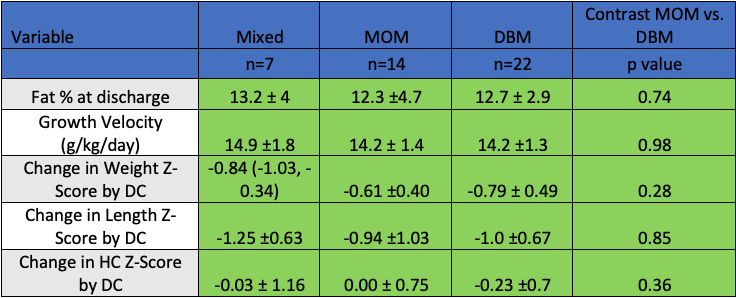Neonatal Fetal Nutrition & Metabolism
Category: Abstract Submission
Neonatal Fetal Nutrition & Metabolism IV
446 - Effect of Mother's Milk Compared to Donor Milk on Growth and Body Composition in Preterm Infants
Sunday, April 24, 2022
3:30 PM - 6:00 PM US MT
Poster Number: 446
Publication Number: 446.335
Publication Number: 446.335
Anna Horner, University of Tennessee Health Sciences Center - - Memphis, TN, Memphis, TN, United States; Mohamad Elabiad, University of Tennessee Health Science Center College of Medicine, Memphis, TN, United States; Ajay Talati, University of Tennessee Health Science Center College of Medicine, Memphis, TN, United States

Anna Horner
Medical Student
University of Tennessee Health Sciences Center - - Memphis, TN
Memphis, Tennessee, United States
Presenting Author(s)
Background: Previous studies have shown that in premature infants, extrauterine growth restriction (EUGR) was more severe with donor breast milk (DBM) utilization when compared to mother’s own milk (MOM). We hypothesized that in premature infants receiving DBM, EUGR was associated with low quantity of macronutrients.
Objective: The purpose of this study was to look at the effects of DBM compared to MOM on growth and body composition in premature infants.
Design/Methods: A retrospective chart review of 43 VLBW patients was performed. Data regarding daily feeding intakes, different milk types received, and different types of fortifications were collected. Nutritional, growth, and demographic data were compared. Air displacement plethysmography measurements to measure body fat were recorded close to 36wk PMA. Cases were divided into two groups, MOM >80% feeding and DBM >80% feeding, for comparison.
Results: Of the 43 patients included in this chart review, 14 received 80% MOM, 22 received DBM, and 7 received a combination of the two until reaching a weight of 1500g. The two groups had similar birth weights, gender distributions and clinical courses. Patients receiving primarily DBM had higher fat intakes (g/kg/d) (MOM 6.1, DBM 7, p< 0.01) leading to higher caloric intakes (Cal/kg/d) (MOM 123, DBM 128, p< 0.01). Lean body mass percentage (p=0.74) as well as weight velocities (g/kg/d), (p=0.98), were similar between the two groups. By discharge, the two groups had shown similar growth patterns with no significant differences in their birth to discharge z-scores in weight, length, and head circumference. Tables 1-3Conclusion(s): When DBM is the primary source of nutrition, higher caloric and fat intake are required to achieve the same growth as babies receiving MOM. Future studies should evaluate if there are any effects of high fat and high calorie DBM intake on long-term neurodevelopmental outcomes in premature infants.
Anna Horner CV 2022.pdf
Table 2: Growth Outcomes
Objective: The purpose of this study was to look at the effects of DBM compared to MOM on growth and body composition in premature infants.
Design/Methods: A retrospective chart review of 43 VLBW patients was performed. Data regarding daily feeding intakes, different milk types received, and different types of fortifications were collected. Nutritional, growth, and demographic data were compared. Air displacement plethysmography measurements to measure body fat were recorded close to 36wk PMA. Cases were divided into two groups, MOM >80% feeding and DBM >80% feeding, for comparison.
Results: Of the 43 patients included in this chart review, 14 received 80% MOM, 22 received DBM, and 7 received a combination of the two until reaching a weight of 1500g. The two groups had similar birth weights, gender distributions and clinical courses. Patients receiving primarily DBM had higher fat intakes (g/kg/d) (MOM 6.1, DBM 7, p< 0.01) leading to higher caloric intakes (Cal/kg/d) (MOM 123, DBM 128, p< 0.01). Lean body mass percentage (p=0.74) as well as weight velocities (g/kg/d), (p=0.98), were similar between the two groups. By discharge, the two groups had shown similar growth patterns with no significant differences in their birth to discharge z-scores in weight, length, and head circumference. Tables 1-3Conclusion(s): When DBM is the primary source of nutrition, higher caloric and fat intake are required to achieve the same growth as babies receiving MOM. Future studies should evaluate if there are any effects of high fat and high calorie DBM intake on long-term neurodevelopmental outcomes in premature infants.
Anna Horner CV 2022.pdf
Table 2: Growth Outcomes

